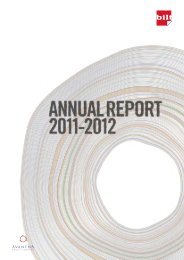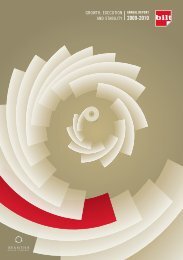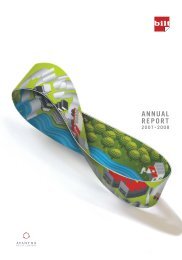Annual Report 2011 - Ballarpur Industries Limited
Annual Report 2011 - Ballarpur Industries Limited
Annual Report 2011 - Ballarpur Industries Limited
You also want an ePaper? Increase the reach of your titles
YUMPU automatically turns print PDFs into web optimized ePapers that Google loves.
16<br />
Unit: SFI<br />
One of the major<br />
achievements on the<br />
Customer servicing side<br />
during 2010–11 was<br />
a 40 per cent drop in<br />
customer complaints as<br />
compared to 2009–10.<br />
This is mainly due to<br />
proactive steps taken<br />
in maintaining quality<br />
during production and<br />
tight Quality Control<br />
Systems across<br />
processes.<br />
Identified potential consumers for fly<br />
ash generated from the coal boilers and<br />
doubled the supply from 30 MT per day<br />
(2009-10) to 60 MT per day (2010-11)<br />
100 per cent utilization of waste acid<br />
generated from Clo 2 Plant in bleaching<br />
stage for pH control, which resulted in<br />
improvement of effluent quality<br />
As a green initiative, constructed five<br />
rain water collection pits for rain water<br />
harvesting.<br />
ballarpur industries limited | annual report 2010–11<br />
unit: ashti<br />
In 2010-11, the Unit produced 53,299 MT<br />
of paper, which was 1,691 MT lower than the<br />
output in 2009-10. This production has been<br />
lower on account of higher downtime and<br />
adverse product mix. After commissioning<br />
of the satellite plant of SMI at <strong>Ballarpur</strong>, the<br />
Unit completely changed over to Precipitated<br />
Calcium Carbonate (PCC) as filler, which has<br />
helped in improving product quality as well as<br />
cost reduction. Further, the Unit has replaced<br />
the primary centri-cleaner pump to a higher<br />
capacity one for improving the centri-cleaning<br />
efficiency, which resulted in the improvement<br />
of product quality. This, combined with<br />
other quality improvement initiatives have<br />
resulted in substantial reduction of customer<br />
complaints by 65 per cent in 2010-11.<br />
In the area of environment protection, the<br />
Unit has successfully carried out retrofitting<br />
and up-gradation of Electrostatic Precipitator<br />
(ESP) to achieve suspended particulate<br />
matter at 50 mg/NM 3 , which is much below<br />
the statutory norms. The Unit has also been<br />
able to reduce water consumption by 16 per<br />
cent per MT of paper produced during the<br />
year by improving the vacuum flume recycling<br />
system and reuse of water in the process<br />
which has finally reduced the effluent water<br />
of the mill by 20 per cent per day thereby<br />
improving the ETP discharge effluent quality.<br />
The Unit catered to the retail business<br />
by producing around 15,214 MT of paper<br />
for various brands like Ten on Ten, Matrix<br />
Premium Multi Purpose Paper (MMPP),<br />
Matrix Premium Digital Paper (MPDP)<br />
and P3 segment. A testimony to the Unit’s<br />
improvement in product quality is the success<br />
achieved in exporting paper to 20 countries<br />
across the globe, where the products are<br />
competing with international brands and<br />
meet high quality norms.<br />
In addition to the existing A-4 packing line,<br />
a second A-4 line has also been shifted from<br />
Unit Sewa and re-commissioned at this Unit,<br />
enabling it to increase the volume of inside<br />
cutting and packing of A-4 Copy paper to<br />
43,242 MT in 2010-11, which is 6,088 MT<br />
higher than the previous year.<br />
As part of management commitment<br />
towards systems implementation, in 2010-<br />
11, the Unit obtained recertification of QMS<br />
ISO 9001:2008, EMS ISO 14001:2004 and<br />
ISO 18001:2007 certification of OHSAS. The<br />
Unit is also Forest Stewardship Council FSC-<br />
COC certified.<br />
unit: sFi<br />
During 2010-11, paper production from the<br />
Unit was 131,909 MTPA, which is about 12<br />
per cent lower than 2009-10. Lower paper<br />
production was mainly due to an annual<br />
shut-down in September and October, 2010.<br />
The annual shut-down is normally once in<br />
18 months for inspection and servicing of<br />
pressure vessels as per the requirements of<br />
Department of Safety and Health (DOSH),<br />
Malaysia. There was an overrun of 9 days<br />
in this annual shut-down, mainly due to<br />
delay in implementation of DCS system on<br />
paper machines. The other factor which<br />
led to lower production was the start up and<br />
commissioning of the new MCO2 plant in<br />
Pulp Mill tie in shut in June <strong>2011</strong>. Out of the<br />
total paper production of the Unit, 40,631<br />
MTPA was exported. The bleached pulp<br />
production was 100,067 MTPA, which was<br />
12 per cent lower than 2009-10.<br />
On the raw material front, the mix has been<br />
changed to increase consumption of Acacia<br />
Mangium against Mixed Tropical Hardwood<br />
to improve paper formation and reduce<br />
production cost. SFI paper grades have<br />
moved up in positioning in terms of quality<br />
amongst its regional competitors. Another<br />
notable parallel occurrence is the significant<br />
drop in paper dirt count.<br />
One of the major achievements on the<br />
Customer servicing side during 2010–11 was<br />
a 40 per cent drop in customer complaints as<br />
compared to 2009–10. This is mainly due to<br />
proactive steps taken in maintaining quality<br />
during production and tight Quality Control<br />
Systems across processes.<br />
As regards plantation activities, the major<br />
change from past practices has been to<br />
directly employ labour rather than relying<br />
entirely on contractors. By the end of 2010-<br />
11, more than 200 Indonesian nationals were<br />
employed on land preparation and planting<br />
activities. This was necessary as contractors<br />
were unable to meet the plantation targets.<br />
The plan is to increase the numbers of<br />
such workers to more than 500 in <strong>2011</strong>-12.<br />
Consequently, plantation coverage increased<br />
from 2,200 hectares (ha) in 2009-10 to 4,100





